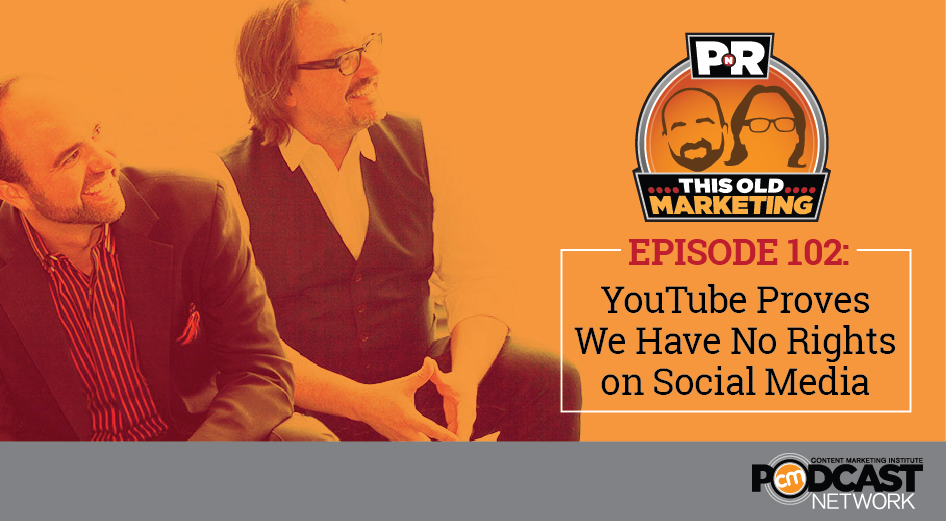
PNR: This Old Marketing with Joe Pulizzi and Robert Rose can be found on both iTunes and Stitcher.
In this week’s episode, Robert and I question YouTube’s controversial decision to force content creators to be part of their new paid subscription program. A companion article describes how this is already starting to happen to ESPN, which has already removed its videos from YouTube. What should content marketers do? We discuss several possibilities. Next, we dig into new Adobe research on what consumers want from digital content and point to an opportunity many brands are overlooking. Finally, we take a closer look at the future of digital and media. Rants and raves include a one-sided overview of traditional marketing strategies and the myopic way in which many publishers tend to approach their advertisers. We wrap up the show with a #ThisOldMarketing example of the week from Johnson & Johnson’s BabyCenter.
This week’s show
(Recorded live October 26, 2015; Length: 1:02:12)
Download this week’s PNR This Old Marketing podcast.
If you enjoy our PNR podcasts, we would love if you would rate it, or post a review, on iTunes.
1. Content marketing in the news
- YouTube gets heavy-handed with its partner creators (5:47): YouTube made its top video creators an offer they literally couldn’t refuse – if they didn’t want their content to disappear, TechCrunch reports. YouTube announced that any “partner” creator who earns a cut of ad revenue but doesn’t agree to sign its revenue share deal for its new YouTube Red $9.99 ad-free subscription will have their videos hidden from public view on both the ad-supported and ad-free tiers. This is already starting to happen, according to the next article.
- ESPN takes its videos off of YouTube (7:01): ESPN has started pulling some of its video content from YouTube. Existing ESPN content on YouTube is now marked as private, and ESPN-owned properties like Grantland have switched over to the network’s proprietary player. Robert and I agree that this is another example of a social media channel changing the rules at will. We discuss what brands can do to prepare now in case YouTube expands its heavy-handed approach to business-focused video channels.
- Study: What consumers want from digital content (16:10): A new study from Adobe examines how consumers feel about content from different sources, and how technical challenges can reduce engagement. Nine out of 10 of the 2,008 consumers surveyed said they multiscreen. Seventy-three percent of consumers said that content “must display well on the device.” Robert believes many brands still only give lip service to mobile. They actually need to rethink their websites to provide highly tailored, customer-focused experiences that play well on all devices.
- Epic deck from Yahoo – predicts what’s happening in tech and media (27:01): Business strategist Michael Wolf recently gave a massive presentation on the future of tech and media in 2016 at The Wall Street Journal’s conference. It contains numerous fascinating insights, reports Business Insider. For example, consumers use a moderate number of apps and websites each month, but spend the majority of their time on only a handful of them. One big opportunity that caught my attention: Audio, because it’s the only medium we can multitask with.
2. Sponsor (33:51)
- Digital marketing 101: Key tools for engagement marketing: Download this e-book from Marketo to learn more about the fundamentals of digital marketing and how you can be successful in today’s modern, complex business landscape. http://bit.ly/marketo-digital-marketing
3. Rants and raves (36:34)
- Robert’s rant: This article from Moz, How to Integrate Traditional & Digital Marketing, provides a comprehensive overview of traditional marketing strategies. It contains many good reminders. But it starts with a quote by ad contrarian Bob Hoffman that claims marketers are helplessly attracted to bright, shiny objects. Robert is tired of this meme. He believes there’s greater risk in assuming that maintaining the status quo is good enough.
- Joe’s rant: I have some concerns about a new article from Nieman Lab titled What’s Actually Working in Digital Advertising? 8 Publishers on How They’re Bringing in Money. It provides advice on how advertisers can communicate more effectively with their audiences. But the only solutions it offers are focused on advertising. I believe they would be more successful if they assumed a more consultative role and helped advertisers be more effective at marketing overall.
4. This Old Marketing example of the week (54:10)
- J&J’s BabyCenter: BabyCenter is the leading online source for information on conception, pregnancy, birth, and early childhood for parents and parents-to-be. Launched in 1997 by the same company that owned E-Toys, it was acquired by consumer products giant Johnson & Johnson two years later. BabyCenter contains an impressive collection of articles, tools and resources that are organized around each step in planning and managing a young family. It has become a trusted resource for many parents with millions of page views each month. The biggest benefit of BabyCenter isn’t leads or sales, but the data it generates. J&J uses it to inform its product development, marketing, and advertising efforts; this AdAge article shares two examples. BabyCenter is an awesome example of how to look at content through a different lens – as an asset – and it’s an outstanding example of #ThisOldMarketing.

For a full list of PNR archives, go to the main This Old Marketing page.




